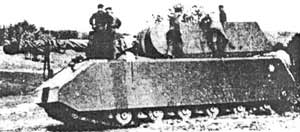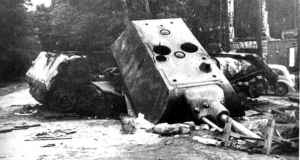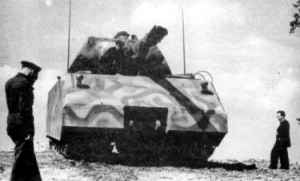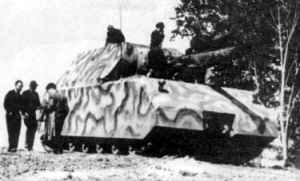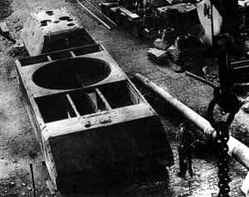| |
The development of super heavy tank started as early as 1941, when Krupp started the studies of superheavy Soviet tanks. In early 1942, Krupp produced designs of Tiger-Maus (VK7001) and PzKpfw VII Lowe (VK7201), but on March 5/6th of 1942, order for heavier tank was placed. Lowe never reached the prototype stage but paved the way for their successor's development. On March 21/22nd of 1942, Porsche received the contract for new 100-ton Panzer - VK10001 / Porsche Typ 205. On April 14/15th, it specified that new 100-ton tank must carry at least 100 rounds of ammunition. VK10001 was to be developed by Professor Ferdinand Porsche and Dr.Muller (Krupp) at the personal demand of Adolf Hitler made in May of 1942. He demanded 120-ton "indestructible" super-heavy tank armed with high performance L/60 or L/72 gun.
The task of producing hulls, turrets and armament was given to Krupp, while Alkett was responsible for the assembly. First specifications demanded that armament should consist of 150mm L/40 gun and 20mm MG151/20 heavy machine gun, while usage of 128mm L/50 was under consideration. It was stated that prototype should be operational before the Spring of 1943. On June 23rd of 1942, Porsche provided their design for improved VK10001 armed with turret mounted 150mm L/37 and 105mm L/70 guns. Porsche promised that first prototype will be ready in May of 1943. In December of 1942, new armaments such as 150mm gun, 127mm naval gun, 128mm Flak and the longest version of 128mm were considered. Also in the same month, it was restated that first vehicle was to be ready in Summer of 1943, followed by the production 5 per month. First official names VK10001 and Porsche Typ 205 ("Mammoth") were used in April of 1942, followed by Maeuschen (Mousy) in December of 1942 and Maus (Mouse) in February of 1943. In January of 1943, Hitler decided that the Maeuschen was to be fitted with turret mounted with 128mm and 75mm guns, while turret mounted with 150mm KwK 44 L/38 or 170mm KwK 44 gun was to be designed for future use. Specification for ammunition storage space were never met and decreased by further modifications.
From the designs emerged 188 tonnes heavy monster. On May 1st of 1943, wooden mockup of the Maus was presented to Adolf Hitler, who agreed on production and ordered series of 150 to be produced. On November 4 of 1943, development of Maus was to be ceased and only one was to be completed for evaluation. In October of 1943, original order placed by Hitler for 150 vehicles was cancelled.
On December 24th of 1943, first turretless prototype was completed by Alkett and was put to the extensive tests. During the tests, the Maus could hardly move due to its enormous weight and power/weight ratio. First prototype V1 (Maus I), was powered by modified Daimler-Benz MB 509 (developed from DB 603 aircraft engine), which could not provide planned speed of 20km/h but only 13km/h in ideal conditions. Also problems arouse with suspension system which had to be modified in order to take the weight of the vehicle. Another problem that emerged from its weight, was that simply there were no bridges able to take the its weight. To overcome this problem Maus had to be provided with a "snorkel" arrangement which allowed it to submerse to the maximum depth of 8 meters. In December of 1943, V1 was fitted with (Belastungsgewicht) simulated turret (representing the weight of the turret) and was tested. Maus I was applied with camouflage paint and marked with red star and hammer and sickle disguised as a captured Russian vehicle.
In March of 1944, second prototype V2 (Maus II) which differed in numerous details from V1 was produced. V2 lacked the powerplant, which was fitted in mid 1944. On April 9th of 1944, Krupp produced the turret, which in June of 1944, was delivered and then mounted on V2 and tested. Krupp produced a turret mounted with 128mm KwK 44 L/55 gun with coaxial 75mm KwK 44 L/36.5 gun and 7.92mm MG34, providing the Maus with an enormous firepower. Maus' main gun could penetrate front, side and rear armor (at 30 degrees from vertical) of Sherman, Cromwell, Churchill, T-34/85 and JS-2 tanks at ranges of 3500+ meters. Turret included mounts for rangefinder (by Zeiss), but was not fully finished and some of the missing components were shipped later on.
Maus I was to be fitted with Krupp's second turret but it was never delivered and it remained fitted with simulated turret. On July 25th of 1944, Krupp reported that two hulls will be available soon and two more later on. On July 27th of 1944, Krupp was ordered to scrap those four hulls. On August 19th of 1944, Krupp informed Porsche that it was order to stop further work on Maus. In September of 1944, second prototype started its tests. It was installed with Daimler-Benz MB 517 diesel engine that made little difference in comparison with previously used engine. Advanced electric steering system was used to steer the vehicle. Its running gear designed by Skoda, consisted of double-wheeled trucks supported by twelve return rollers with 1100mm wide tracks. The crew had to be provided with oxygen supplied by built-on fans/ventilators when all the hatches were closed.
In order to transport the Maus, special 14-axle railroad transport car (Verladewagon) was produced by Graz-Simmering-Pauker Works in Vienna. From mid January to early October of 1944, trials took place at armored vehicle proving grounds in Kummersdorf (near Berlin) and then at Porsche proving grounds at Boblingen. Tests were long, delayed by engine failures and production delays caused by Allied bomber attacks on German factories. During tests, it was determined that in case of any failure each Maus would have to be towed by two other Maus tanks. It is also reported that Germans worked on Flakzwilling 8.8cm auf Maus, which was to be Maus mounted with a modified turret housing two 88mm Flak 43 guns and used as heavy Flakpanzer.
Overall, Maus was an interesting design but it would be of limited combat value because of its poor mobility and heavy weight making it more of a mobile fortification rather than a super tank. One fully assembled example (V2 turret mounted on V1 hull) was tested at Kubinka in 1951/52 and can be seen today in the Museum of Armored Forces in Kubinka (near Moscow) in Russia.Some sources state that according to Porsche, Hitler's aim for the Maus was to plug holes in the Atlantic coastal defenses on the Western Front, where it's limited range and mobility wouldn't have been too much of a hindrance. The popular version states that V2 prototype was blown up by the personnel at proving grounds in Kummersdorf, while some sources state that actually V2 saw combat while defending the facility at Kummersdorf. When war ended, almost finished V1 turret and third hull were found at Krupp facilities in Essen.
Overall, Maus was an interesting design but it would be of limited combat value because of its poor mobility and heavy weight making it more of a mobile fortification rather than a super tank. One fully assembled example (V2 turret mounted on V1 hull) was tested at Kubinka in 1951/52 and can be seen today in the Museum of Armored Forces in Kubinka (near Moscow) in Russia.
|
|
|



